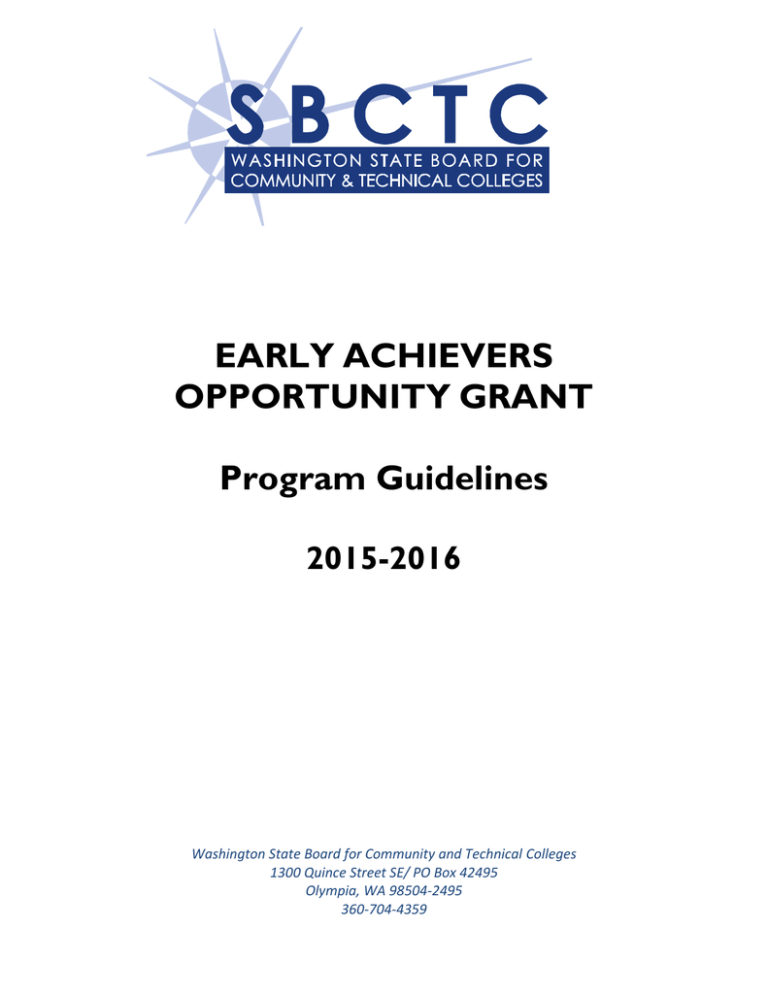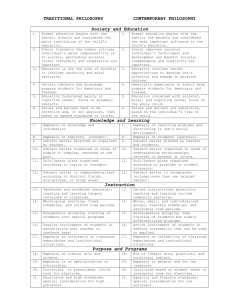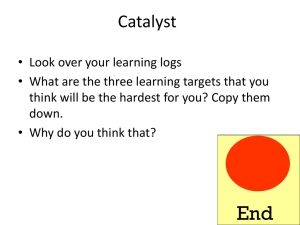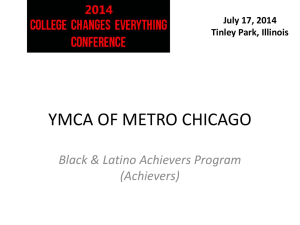EARLY ACHIEVERS OPPORTUNITY
advertisement

EARLY ACHIEVERS OPPORTUNITY GRANT Program Guidelines 2015-2016 Washington State Board for Community and Technical Colleges 1300 Quince Street SE/ PO Box 42495 Olympia, WA 98504-2495 360-704-4359 Early Childhood Education Staff Washington State Board for Community and Technical Colleges Kathy Goebel Policy Associate, Workforce Education Phone 360-704-4359 Fax 360-704-4418 Email kgoebel@sbctc.edu Mason Norman Workforce Services Coordinator Phone 360-704-4337 Fax 360-704-4418 Email mnorman@sbctc.edu i 2015-2016 EARLY ACHIEVERS OPPORTUNITY GRANT PROGRAM GUIDELINES TABLE OF CONTENTS CHAPTER 1 BACKGROUND AND OVERVIEW ............................................................................. 1 CHAPTER 2 COLLEGE ALLOCATIONS, FUNDING, AND PROGRAM REQUIREMENTS ....................... 4 PROGRAM REQUIREMENTS .............................................................................................................................. 5 CHAPTER 3 STUDENT ELIGIBILITY DETERMINATION ................................................................... 8 STUDENT ELIGIBILITY REQUIREMENTS ............................................................................................................. 8 FINANCIAL AID AND CODING ............................................................................................................................ 9 CHAPTER 4 REFUNDS.............................................................................................................. 10 REFUNDS ......................................................................................................................................................... 10 CHAPTER 5 PROGRAM REPORTING ......................................................................................... 11 REPORTS .......................................................................................................................................................... 11 STUDENT PROGRAM COMPLETIONS .............................................................................................................. 11 CHAPTER 6 FREQUENTLY ASKED QUESTIONS .......................................................................... 12 ii CHAPTER 1 BACKGROUND AND OVERVIEW In 2011, the Department of Early Learning (DEL) was awarded federal Race-to-the-Top Early Learning Challenge grant funds to achieve several goals DEL has been developing with the assistance of stakeholder groups over the past few years to support the overarching goal of ensuring the success of Washington’s youngest learners. Goals include: 1. Adoption of the Early Learning Plan in 2010 containing goals, strategies and measures for an early learning system. This is the framework for all Department of Early Learning initiatives leading to improved outcomes for children. 2. Refinement of Washington’s Early Learning and Development Benchmarks serving as a source document informing parents and caregivers about expectations for children’s development and learning. 3. Expansion of the Washington Kindergarten Inventory of Developing Skills (WaKIDS) assessment created to measure the impact of early learning interventions and inform kindergarten instruction. 4. Development of a high-quality, tiered Quality Rating and Improvement System (Early Achievers) focusing on improving outcomes for children and providing tiered incentives and high-quality professional development for child care and early learning providers. Working with the Professional Development Consortium, DEL created a strategic plan for the professional development system, including defining core competencies for the early care and education workforce. Recommendations from the work completed by the consortium led to a statewide implementation plan with four priorities: Adoption of the Washington State Core Competencies for Early Care and Education Professionals (Core Competencies). Statewide expansion of the Tiered Quality Rating and Improvement System – now called the Early Achievers program. Development of an integrated professional development registry (MERIT). Implementation of a comprehensive quality assurance process for approving state trainers. The Department of Early Learning has set the following targets for professional development for early child care providers and educators: 2012 – 15% of the total early child care and education professionals have completed an Associate degree. 2013 – 20% of the total early child care and education professionals have completed an Associate degree. Washington State Board for Community and Technical Colleges 2015-16 Early Achievers Opportunity Grant Guidelines Updated 5/21/15 Page 1 of 17 2014 – 25% of the total early child care and education professionals have completed an Associate degree. 2015 – 30% of the total early child care and education professionals have completed an Associate degree. In the spring of 2011, the Early Childhood Teacher Preparation Council developed a proposal to increase the number of employed child care providers earning formal early childhood education certificates and degrees offered through community and technical colleges by creating and implementing a new financial aid award. Race-to-the-Top funding has been identified to support this financial aid program. The Early Achievers Opportunity Grant (EAOG) funds directly support the second goal – Statewide expansion of the Tiered Quality Rating and Improvement System and will help increase the number of professionals earning Early Childhood Education certificates and Associate degrees. The proposal also included creating uniform education programs with common course numbering that participating colleges would be invited to incorporate into their Early Childhood Education programs. The Certificate Work Group, comprised of Early Childhood Education directors and faculty from several community and technical colleges, have created three articulated certificate pathways. 1) State Initial Early Childhood Education Certificate (12 credits). 2) State Short Early Childhood Education Certificates of Specialization (8 additional credits per certificate). General Early Childhood Education Infant-Toddler Care, School-Age Care, Family Child Care Administration 3) State Early Childhood Education Certificate (27-32 additional credits) The work group completed the certificate alignment and common course numbering project in spring, 2012. The Articulation and Transfer Council approved the common courses created by the work group at their meeting on April 19, 2012. The Instruction Commission approved the courses at their spring meeting on May 17-18, 2012. Over eighty percent of Washington’s community and technical colleges have incorporated the state certificates into their Early Childhood Education programs. In 2014-15, twenty-three colleges participated in the Early Achievers Opportunity Grant program. College Bates Technical College Bellevue College Centralia College Clark College Edmonds Community College Everett Community College Green River College Highline College Lake Washington Institute of Technology Lower Columbia College North Seattle College Quarter Program Started Winter, 2013 Fall, 2013 Fall, 2013 Winter, 2013 Fall, 2013 Fall, 2013 Fall, 2013 Winter, 2013 Fall, 2013 Winter, 2013 Winter, 2014 Washington State Board for Community and Technical Colleges 2015-16 Early Achievers Opportunity Grant Guidelines Number of FTES 30 FTES 15 FTES FTES 20 FTES 20 FTES 5 FTES 30 FTES 20 FTES 15 FTES 20 FTES 5 FTES Updated 5/21/15 Page 2 of 17 College Olympic College Peninsula College Pierce Colleges (Puyallup & Fort Steilacoom Renton Technical College Seattle Central College Skagit Valley College South Puget Sound Community College Walla Walla Community College Wenatchee Valley College Whatcom Community College Yakima Valley Community College System Quarter Program Started Fall, 2012 Fall, 2013 Fall, 2012 Fall, 2014 Fall, 2014 Fall, 2014 Fall, 2013 Fall, 2013 Fall, 2013 Fall, 2013 Fall, 2013 Washington State Board for Community and Technical Colleges 2015-16 Early Achievers Opportunity Grant Guidelines Number of FTES 20 FTES 5 FTES 30 FTES 5 FTES 5 FTES 5 FTES 25 FTES 5 FTES 20 FTES 20 FTES 20 FTES 350 FTES Updated 5/21/15 Page 3 of 17 CHAPTER 2 COLLEGE ALLOCATIONS, FUNDING, AND PROGRAM REQUIREMENTS The 2015-16 allocation recommendation assumes the following distribution of funds: 1. Early Achievers Opportunity Grant (EAOG) funds will be distributed to community and technical colleges that apply and are selected to participate in the financial aid program during the 2015-16 academic year. 2. One FTES is equivalent to 45 credits. For example, a student who enrolls for 18 credits fall quarter, 13 credits winter quarter and 15 credits spring quarter results in 1.0 FTES. (18 +13+15=45). The enrollment of several part-time students may be added together to determine FTES. For example, nine students who enroll in a five credit course would total 45 credits or 1.0 FTES. 3. The EAOG funding will be granted to the colleges in whole FTES increments (5, 7, 12, etc.) not partial FTES increments (3.4, 7.2, 15.7, etc.). 4. Tuition and fees The Early Achievers Opportunity Grant covers tuition and mandatory fees for eligible students up to 52 credits for an Early Childhood Education State Certificate. If the student earns a one-year State Certificate in Early Childhood Education, she or he is then eligible for further Early Achievers Opportunity Grant funding to support enrollment in an Early Childhood Education Associate degree program up to 45 additional credits. The individual college shall determine the cost of full-time attendance and mandatory fees based on the rate of the institution’s tuition and mandatory fees. Example: 45 credits of tuition for 2015-16 is approximately $4,000. The college could also assess additional mandatory fees, such as lab or technology fees equaling $300. The Early Achievers Opportunity Grant funding will cover up to $4,800 for 45 credits or 1 FTES. 5. Textbooks and instructional materials Each college will receive $1,000 for each FTES funded through the Early Achievers Opportunity Grant program to reimburse students for the purchase of required textbooks and other instructional materials. If needed, these dollars may be moved to the tuition/fees budget categories. Grant funds may not be used to purchase computers, laptops, scientific calculators, etc. for students. Grant funds may not be used to purchase paper, notebooks, pens or other types of supplies. Updated Updated 6. Wrap-around student services Each college will receive $750 for each FTES funded through the Early Achievers Opportunity Grant program. The college may utilize this funding for wrap-around individualized support services including, but not limited to; student success classes, tutoring, counseling, retention strategies, and emergency conditions that if resolved will help maintain the student in college. If needed, these dollars may be moved to the tuition/fees and books/instructional materials budget categories. 7. Staff Point-of-Contact In addition, the college will receive $1,000 for every FTES to support an Early Childhood Education Point-of-Contact. The Point-of-Contact will advise and support Early Achievers Opportunity Grant Washington State Board for Community and Technical Colleges 2015-16 Early Achievers Opportunity Grant Guidelines Updated 5/21/15 Page 4 of 17 recipients. The college may utilize this funding for the salary, benefits, goods & services, and travel for one or more staff performing Point-of-Contact duties (i.e. Early Achievers Opportunity Grant Coordinator). Colleges may not exceed $1,000 per FTES for POC expenses. 8. Colleges must spend at least $5,800 from this grant per FTES on EAOG participants’ tuition, and required books, fees and instructional materials. Updated 9. The college must apply for the full amount of funds per the following table. For example, if requesting 10 FTES, the college must apply for exactly $7,550. Please see Fiscal Guidelines for information on how funds may be budgeted and how funds may be moved between budget categories. EAOG Funding 1 FTES 2 FTES 3 FTES 4 FTES 5 FTES 6 FTES 10 FTES 15 FTES Tuition & Fees Required Books and Instructional Materials Student Support & Wrap-Around Services $4,800 $9,600 $14,400 $19,200 $24,000 $28,800 $48,000 $72,000 $1,000 $2,000 $3,000 $4,000 $5,000 $6,000 $10,000 $15,000 $750 $1,500 $2,250 $3,000 $3,750 $4,500 $7,500 $11,500 College Point-ofContact $1,000 $2,000 $3,000 $4,000 $5,000 $6,000 $10,000 $15,000 Total $7,550 $15,100 $22,650 $30,200 $37,750 $45,300 $75,500 $113,250 10. The Early Achievers Opportunity Grant funds must be expended no later than December 31, 2015. PROGRAM REQUIREMENTS Early Childhood Education Point-of-Contact The college will establish an Early Childhood Education Point-of-Contact to advise and support Early Achievers Opportunity Grant recipients. College staff identified as the point-of-contact will: o Provide accurate information to students about the Department of Early Learning’s initiatives such as the Early Achievers program-Washington’s quality rating and improvement system, the Education Matrix, and the Managed Education and Registry Information Tool (MERIT). o Provide accurate information about the college’s grant application process, admission requirements and processes, required financial aid forms, student placement assessments, registration procedures and services provided to potential Early Achievers Opportunity Grant recipients. o Help students plan their college program and course schedule customized to the needs of each student. Washington State Board for Community and Technical Colleges 2015-16 Early Achievers Opportunity Grant Guidelines Updated 5/21/15 Page 5 of 17 o Provide information about financial aid, assist students with the required forms, and coordinate the development of financial aid packages for each student according to his/her needs. o Coordinate prior learning assessments and the awarding of credit as requested by the student. o Coordinate wrap-around support services such as tutoring, mentoring, study groups, eLearning workshops, or emergency assistance as needed. o Track student progress and deploy retention activities as needed. o Track student completions using transcript reports and assist students as they submit certificate and degree applications. o Assist students with any other issues that may arise related to the Early Achievers Opportunity Grant program. o By each due date, complete and submit monthly reports to the Early Achievers Opportunity Grant Coordinator. Funding for an Early Childhood Education State Certificate The contract with the Department of Early learning sets forth the requirements for Early Achievers Opportunity Grant (EAOG) funding. A student may receive EAOG funding for 52 credits of eligibility, but for no more than four years from initial receipt of grant funds. Additional funding for an Associate’s Degree Students who successfully complete a one-year Early Childhood Education State Certificate are eligible to receive EAOG funding for an additional 45 credits for coursework required for an Associate’s degree in Early Childhood Education, but for no more than four years from the receipt of grant funds for the second 45 credits. Military service deployment Students called up to active military duty are exempt from the continuous four year enrollment requirement. Colleges should extend the timeframe to exclude the time away for the military service. However, total enrollment should not exceed four years of college attendance. This may include required related general education courses in a program. (See FAQs at the end of this document for more information) Academic requirements The student must maintain a minimum cumulative 2.0 grade point average and meet the Early Childhood Education program and colleges’ satisfactory academic progress policies. If a student's cumulative grade point average falls below 2.0, the student may petition the college. The college has the authority to establish a probationary period until such time as the student's grade point average reaches required standards. Washington State Board for Community and Technical Colleges 2015-16 Early Achievers Opportunity Grant Guidelines Updated 5/21/15 Page 6 of 17 Eligible Early Childhood Education programs An EAOG eligible education program includes the standardized statewide Early Childhood Education stackable certificates and degree programs that have been approved by the State Board for Community and Technical Colleges (see Criteria for Program Approval). Grant recipient priorities In the event a college has more eligible Early Achievers Opportunity Grant recipients than available funds, first priority will be given to eligible students employed in Early Achievers child care facilities, family home care and Head Start/ECEAP programs that have been rated. Second priority will be given to students employed in participating facilities and programs that have not yet been rated. Participating colleges will be provided information about providers who have been rated by the Early Achievers program. Colleges are encouraged to explore and utilize other financial aid options for eligible students. Washington State Board for Community and Technical Colleges 2015-16 Early Achievers Opportunity Grant Guidelines Updated 5/21/15 Page 7 of 17 CHAPTER 3 STUDENT ELIGIBILITY DETERMINATION STUDENT ELIGIBILITY REQUIREMENTS Eligible Early Achievers Opportunity Grant (EAOG) students must: Make a formal application to the program Be a Washington State resident student as defined in RCW 28B.15.012. Be employed at a child care facility, family home care or Head Start/ECEAP program that is actively participating in the Department of Early Learning’s Early Achievers (QRIS) program. The student must work a minimum of 10 hours a week or 40 hours per month at an eligible child care facility. The student must also have worked at the facility for a minimum of three (3) months. The Department of Early Learning will provide the colleges with access to information regarding eligible child care facilities. The student must provide work history documentation to the college. Enroll in an Early Achievers Opportunity Grant-eligible education program. There are no income level eligibility requirements. To be eligible for Early Achievers Opportunity Grant (EAOG) consideration, the student must NOT: Be in unsatisfactory academic progress. Owe a repayment to the EAOG program. Receive funds beyond 52 credits, unless the student has completed a one-year credential in Early Childhood Education and is continuing her or his enrollment to pursue an Associate’s degree in Early Childhood Education. Then the student is eligible for grant funding for an additional 45 credits. Have exceeded $1,000 for books and instructional materials. Have exceeded the total tuition and fees cost. Students must complete a formal application for the Early Achievers Opportunity Grant program. Each college has the authority to create their Early Achievers Opportunity Grant application. The application must include a personal interview, an essay, or written responses to questions and verification of work history. Include a release in the application so the student may be contacted in the future either for an exit interview, media contact, Early Achievers Opportunity Grant satisfaction survey or data tracking purposes. Financial Aid Eligibility Students who meet all eligibility requirements are not required to file a Free Application for Federal Student Aid (FAFSA) application. However, some students may benefit from additional student financial aid or aid beyond the Early Achievers Opportunity Grant program that is scheduled to end December 31, 2015. The intent is for a student to leverage all eligible funds to decrease his or her loan indebtedness. An eligible student may receive an Early Achievers Opportunity Grant, Worker Retraining, Work First, Opportunity Grant, Pell Grant, State Need Grant, Work Study, and other forms of state and federal financial aid. Washington State Board for Community and Technical Colleges 2015-16 Early Achievers Opportunity Grant Guidelines Updated 5/21/15 Page 8 of 17 FINANCIAL AID AND CODING An eligible student may receive Early Achievers Opportunity Grant for tuition and mandatory fees up to 52 credits. If the student has completed a one-year certificate in Early Childhood Education, and meets eligibility requirements, she or he may receive Early Achievers Opportunity Grant funding for an additional 45 credits when enrolled in an Associate degree program in Early Childhood Education. Early Achievers Opportunity Grant students may receive up to $1,000 for books and other instructional materials. It is acceptable for a full-time student to receive an award of $333 a quarter for books and other instructional materials or $250 a quarter if she or he is attending four quarters (summer). This disbursement may be made directly to the student upon receipt of documentation the payment made was for eligible costs. If the student attends less than full-time then the award should be prorated. Students receiving Early Achievers Opportunity Grant funds must receive an accepted award status code, (code 2) in the Financial Aid System (FAM). The financial aid award codes are the financial aid program codes (FAPC) below without the zero in front. Opportunity Grant Financial Aid Program Codes Award Code FAPC Description EA 0EA EB 0EB EC 0EC ED 0ED E0 0E0 EAOG-Tuition (Tuition and Fees) EAOG-Books (Books, supplies, etc…) EAOG-Childcare (Emergency child care) EAOG-Trans Emergency transportation EAOG-Other (Tutoring, exams/licensing fees, career services, etc...) Washington State Board for Community and Technical Colleges 2015-16 Early Achievers Opportunity Grant Guidelines Updated 5/21/15 Page 9 of 17 CHAPTER 4 REFUNDS REFUNDS Any student receiving Early Achievers Opportunity Grant funding who officially or unofficially withdraws will have funds returned to the Early Achievers Opportunity Grant institutional account based on the college refund policy. All Early Achievers Opportunity Grant funds collected from student refunds may be re-awarded to other Early Achievers Opportunity Grant eligible students if refunds are received in the same fiscal year as disbursed. Please follow your college’s standard refund policy. Should the student re-enroll at a later date, those funds surrendered will apply and count toward the academic year Early Achievers Opportunity Grant tuition/fees funding maximum. There typically are no refunds for books/instructional materials that have been purchased. Washington State Board for Community and Technical Colleges 2015-16 Early Achievers Opportunity Grant Guidelines Updated 5/21/15 Page 10 of 17 CHAPTER 5 PROGRAM REPORTING REPORTS The State Board for Community and Technical Colleges (SBCTC) automatically receives a quarterly report from the data warehouse on students receiving Early Achievers Opportunity Grants. This report provides only a small ‘snap-shot’ of the grant data. For students to be included in the Early Achievers Opportunity Grant reports, a student must: 1. Have an AWD-CODE matching the FAPC codes in the Financial Aid System (FAM) 2. Have an AWD-STATUS = 2 and an AWD-AMOUNT greater than 0 3. Be enrolled in a college class (in SMIS) during the quarter being reported 4. This data must be entered into the Financial Aid system prior to the quarterly run of MIS finals. To collect more narrative data or data not available through the FMS and SMS databases, a monthly report will be due. Colleges’ Points-of-Contact will be sent a report template upon approval of their grant application. Monthly reports are due on the last business day of every month. July 31, 2015 August 31, 2015 September 30, 2015 October 30, 2015 November 30, 2015 December 31, 2015 The data collected will assist with Department of Early Learning with Race-to-the-Top grant reporting requirements regarding student participation. STUDENT PROGRAM COMPLETIONS As student retention is measured by continued enrollment and/or program completion, it is essential that all students completing one or more programs be coded with the appropriate exit code. The most common exit codes for Early Achievers Opportunity Grant students are as follows: 1 Associate Degree 2 Certificate, >= 90 credits 3 Certificate, 45-89 credits 4 Certificate, < 45 credits The full listing of exit codes can be found under “Completions” on the SBCTC Data Warehouse web page or check with your college registrar. Washington State Board for Community and Technical Colleges 2015-16 Early Achievers Opportunity Grant Guidelines Updated 5/21/15 Page 11 of 17 CHAPTER 6 FREQUENTLY ASKED QUESTIONS 1. What is “Early Achievers”? Early Achievers is the Department of Early Learning’s (DEL) quality rating and improvement system (QRIS). Early Achievers is Washington’s voluntary program for helping licensed child care providers and other early learning programs offer high-quality care and provide children with the best possible start in life. Early Achievers offers child care providers and their employees’ access to coaching, professional development opportunities and other resources that support high-quality child care at no cost to providers or families. The Early Achievers Opportunity Grant program offers eligible child care providers and their employees’ financial assistance to enroll in Early Childhood Education programs offered at community and technical colleges across the state. Updated 2. Are the 2015-16 Early Achievers Opportunity Grants competitive? Yes, the grants are competitive for 2015-16. Applications will read and scored in early May and awards will be made when approved by the SBCTC. The SBCTC hopes to fund as many community and technical college Early Childhood Education programs as possible within available funding. 3. Does the student need to be 18 years old to receive the grant? The student does not need to be 18, but must be matriculated into the college as an adult. Dual credit students or high school students are not eligible to receive the grant. 4. How can I award the student the $1,000 for required books and instructional materials? The Washington Financial Aid Association has determined the average cost of books is $1,000 a year. Full-time Early Achievers Opportunity Grant students may receive up to $1,000 an academic year for required books and instructional materials. It is acceptable for a full-time student to receive an award of $333 a quarter for required books and instructional materials or $250 a quarter if they are attending four quarters (summer). If a student attends less than full-time, then the award must be prorated. Programs with higher initial quarter books or instructional material costs may adjust the award accordingly. This disbursement may be made directly to the student upon receipt of documentation the payment made was for eligible costs. Colleges must retain receipts or bookstore vouchers for all purchases of required books and instructional materials. 5. May the college cut a check directly to the student for books and instructional materials? As this grant is funded by federal funds, we must all be very vigilant about following federal (and state) rules, processes, etc. The best thing to do, of course, is for students to purchase books at the bookstore using vouchers or through some kind of process where your bookstore sends charges to your department to be paid from the grant. This makes it much easier for your college to have all required documentation in place, which is needed for audit purposes. In rare instances where that isn’t an option, the students must purchase their books, turn in a receipt, and get reimbursed from the grant. Federal funds, such as this grant, cannot be given to a student prior to making a purchase. Washington State Board for Community and Technical Colleges 2015-16 Early Achievers Opportunity Grant Guidelines Updated 5/21/15 Page 12 of 17 6. May the program purchase notebooks, binders or folders using student services funding for orientation materials that are given to students when they enroll in the program? Federal funds may not be used for this purpose. 7. If a student meets all eligibility criteria, but works at more than one child care facility – only one of which is participating in the Early Achievers program – is the student eligible to receive Early Achievers Opportunity Grant funding? If the student works a minimum of 10 hours a week or 40 hours a month at the child care facility participating in the Early Achievers program or a combination of facilities that are participating in the Early Achievers program, the student is eligible to receive grant funding. 8. If a student is receiving Washington Scholars funding from Child Care Aware, may the student also receive Early Achievers Opportunity Grant funding to pay for any eligible expenditures that are not covered by the Washington Scholars aid? We are not allowed to use both funding sources for one student. If the student is participating in the Washington Scholars program, the student may not also receive Early Achievers Opportunity Grant funding for any expenditure. The student must choose which program best meets his or her needs. 9. What if a student is receiving other types of financial aid such as a Student Need Grant, Pell Grant, or other type of aid (not Washington Scholars funding – see question 9)? May the student also receive Early Achievers Opportunity Grant funding to pay for any eligible expenditures that are not covered by other aid? If the student is receiving financial aid other than the Washington Scholars program, the student may receive funding for expenditures not covered by other forms of financial aid up to the amount of funding for which the student is qualified to receive. For example, if the student qualifies for $6,000 of aid and the Pell Grant covers only $5,000, then up to $1,000 of Early Achievers Opportunity Grant funding can be used. The student must be coded correctly so that he or she is counted as an Early Achievers Opportunity Grant recipient and the student must receive the services of the Early Achievers Point-of-Contact and other support staff described in the college’s Early Achievers Opportunity Grant application. 10. If a student is receiving other types of financial aid in addition to Early Achievers Opportunity Grant funding, how should I record enrolled credits on the monthly report? Record all the credits the student is carrying on the report regardless of how the credits are funded. You do not have to sort the number of credits by the funding source. This is the way credits are reported for the regular Opportunity Grant program. The SBCTC understands that credits may be over-reported in the system because many students receive financial aid from multiple sources. 11. If a student has completed a 45 credit (or the equivalent of a one-year) certificate in Early Childhood Education, but it is not the standardized statewide certificate, may the student receive funding from the Early Achievers Opportunity Grant to pursue an Associate degree in Early Childhood Education? If a student has already completed a 45 credit certificate in Early Childhood Education, meets eligibility requirements for employment and is pursuing an Associate’s degree in Early Childhood Education, he or she may receive Early Achievers Opportunity Grant funding up to 45 credits. This applies even if the student has not completed any of the stackable certificates prior to continuing his or her degree program in Early Childhood Education. Washington State Board for Community and Technical Colleges 2015-16 Early Achievers Opportunity Grant Guidelines Updated 5/21/15 Page 13 of 17 12. If a student is employed by a child care facility participating in the Early Achievers QRIS program and receives Early Achievers Opportunity Grant funds to support his/her enrollment in an Early Childhood Education program, but then becomes unemployed (laid-off, quits, gets fired), may that student continue to be eligible for Early Achievers Opportunity Grant funds? The intention of the grant is to support child care providers employed at facilities that are participating in the Early Achievers QRIS program. The employment status of Early Achievers Opportunity Grant recipients should be verified annually – at a minimum. If a grant recipient is no longer employed at an eligible facility, the student may no longer receive Early Achievers Opportunity Grant funding. The student may be eligible for other financial aid programs administered through the college. 13. May a student “stop out” for a quarter or two and still retain an Early Achievers Opportunity Grant? (Military/Family/Medical leave) Yes, students who require medical, maternity or family leave may discontinue their enrollment for one or more quarters. This is a situation similar to students called up to active military duty that is described on page 6 under Program Requirements. Students under these circumstances are exempt from the continuous four year enrollment requirement, but must meet eligibility requirements when they return. Colleges should extend the grant timeframe to exclude the time away due to leave. For example if a student completes four straight academic quarters and then must miss the next two quarters due to maternity leave, she may then return to school with three years remaining on her grant eligibility. In other words, she has not “lost” two quarters while she was away. 14. When does a student’s clock start ticking for using the 52 credits of Early Achievers Opportunity Grant eligibility? A student may receive Early Achievers Opportunity Grant funding for a maximum of 52 credits of eligibility, but no more than four years from initial receipt of grant funds. Once a student has been identified as an Early Achievers Opportunity Grant student either by receiving grant funds for tuition, books, instructional materials, or by receiving wrap around services, the student’s four years of eligibility begins to diminish. A student will begin to use his or her 52 credits of eligibility when grant funds have paid for tuition and fees for the student’s first course. For example, a student whose tuition is being paid by another source may be eligible to receive Early Achievers Opportunity Grant funding for books. The student’s 52 credits of eligibility have not been used, but the student has begun to use his or her four years of eligibility. The student’s eligible credits will begin to diminish when the Opportunity Grant has been used to pay for the tuition and fees (up to 52 credits). Keep in mind that a student may not receive more than $1,000 for required books and instructional materials. Another example is a student who is enrolled in four courses required for an Early Childhood Education credential (5 credits each) per quarter for three quarters (60 credits total). The college can make the decision to use Early Achievers Opportunity Grant funds to pay for two quarters at 20 credits each (40 credits total) and then 12 credits of the third quarter (52 credits of eligibility used total), or the college can fund 18 credits per quarter for two quarters and 16 credits the third quarter (for a total of 52) with the student’s additional credits per quarter being paid by the student or other financial aid/outside source funds. Washington State Board for Community and Technical Colleges 2015-16 Early Achievers Opportunity Grant Guidelines Updated 5/21/15 Page 14 of 17 15. I have a student with five credits of Early Achievers Opportunity Grant eligibility remaining but the student has not used $1,000 books and supplies. May we reimburse the student for required books and supplies up to $1,000 if he/she is actually taking a full-time load? Yes, if the student’s credit load is full-time, then you may pay full-time books and instructional materials. Once the student has used up his or her 52 credits of eligibility, then the student is no longer eligible for textbooks and instructional materials even if four years has not passed. 16. What if a student has very expensive textbooks and instructional materials the first quarter but only attends part-time each quarter? Is there flexibility in prorating the award? The books and supplies need to be prorated if the student attends less than full time, but book expenditures may be prorated for the year rather than the quarter (this is different than traditional aid). Example: If you have an Early Achievers Opportunity Grant student taking seven credits, he or she is considered a ½ time student. Half-time or 50 percent of the student’s $1,000 books and instructional materials would be $500 for the year. If the student has higher costs in the first quarter then you may reimburse up to the $500 the first quarter, but not exceed the $500 for the total academic year unless the student enrolls in enough courses to be considered ¾ or full-time in future quarters. Using the example above, if the student enrolls in courses equal to ¾ - time the second quarter, she or he is eligible for $250 in additional funding for textbooks and instructional materials ($750 total). Of course a school may choose to go the traditional route of prorating each quarter – the example above is just an option. 17. May Early Achievers Opportunity Grant funds pay for a repeated class? Yes, you may use Early Achievers Opportunity Grant (EAOG) funds for a repeated a class (even if EAOG paid for it previously), but the repeated class diminishes the students 52 credits of eligibility. Of course, the student must abide by the college’s Satisfactory Academic Progress policy. 18. What type of Satisfactory Academic Progress (SAP) Policy must my college implement? The Early Achievers Opportunity Grant (EAOG) guidelines indicate that a student must maintain a cumulative 2.0 grade point average. If a student's cumulative grade point average falls below 2.0, the student may petition the college. The college has the authority to establish a probationary period until such time as the student's grade point average reaches required standards. Other than the guidelines above, your college may decide to establish a policy or apply an existing policy to the Early Achievers Opportunity Grant. Your college may decide to use the same policy as traditional financial aid, or your college may allow Early Achievers Opportunity Grant recipients to receive funding even if they are on suspension from traditional financial aid. Your Early Achievers Opportunity Grant team should decide the process. Make sure you define your policy and consistently apply it. 19. Will Early Achievers Opportunity Grant pay for pre-requisites? The Early Achievers Opportunity Grant (EAOG) allows a “required related” course to be included in the EAOG funding. If a student is required to take a developmental/remedial class or a pre-requisite in order to start her or his program, then these types of classes may be included in the funding. However, the student may only receive 52 credits of funding, including required related courses, so make sure the student understands this policy and has other funding sources to finish his or her program. Washington State Board for Community and Technical Colleges 2015-16 Early Achievers Opportunity Grant Guidelines Updated 5/21/15 Page 15 of 17 The risk with funding the pre-requisites is that the student may run out of funding and then leave the program affecting your college’s retention and completion numbers. Once you have decided upon your local policy, define it in writing and consistently apply it. 20. How often may we award emergency funds? Individual colleges may decide to award emergency funding more than once a year for a different emergency, or the college may decide to only offer the funding once a year per student. It is up to the college to make the decision and define its procedures. An example of awarding emergency funding more than once per year: A student has a shut off notice for power and brings the documentation to the college. After reviewing the request, you (or your team) decide the student is eligible and award the student Early Achievers Opportunity Grant emergency ‘Other’ (Financial aid program code 0E0) A few months later the student comes in and her car has broken down and she needs bus fare for the remainder of the term. After reviewing the student’s request, you may decide to award the student EAOG emergency funds ‘transportation’ (Financial aid program code 0ED) due to a different emergency situation. 21. How do you calculate a Full Time Equivalent Student (FTES)? In Washington’s community and technical college system, an FTES is the equivalent of one student enrolled for 15 community or technical college credits per quarter totaling 45 credits per year. Examples of 1 Full-time Equivalent: Credits Student Marlene Summer 0 Fall 15 Winter 15 Spring 15 Total 45 Student Yvette Summer 3 Fall 18 Credits Winter 12 Spring 12 Total 45 Student Holly Connie Laura Summer 3 0 0 Fall 7 5 0 Credits Winter 5 8 2 Spring 5 5 5 Total 20 18 7 45 Calculating FTES: Credits Student Ann Pat Jodi Nancy Jennifer Heather Peggy Chris Kim Summer 3 8 5 12 0 0 0 0 0 Fall 2 12 5 15 3 12 10 3 7 Washington State Board for Community and Technical Colleges 2015-16 Early Achievers Opportunity Grant Guidelines Updated 5/21/15 Page 16 of 17 Jan Sharene Glenda Total 0 0 0 28 8 7 15 99 Divide the number of credits by 45 to determine the FTES. (45 credits = 1 FTE) 28 + 99 = 127 / 45 = 2.8 FTES 22. Must potential grant recipients meet poverty guidelines to be eligible for funding? For 2015-16 there are no income level eligibility requirements. 23. Are child care providers who work for Head Start, ECEAP or Seasonal Head Start programs eligible for Early Achievers Opportunity Grant funding? Yes, but the Department of Early Learning has set some requirements. Colleges offering Early Achievers Opportunity Grants must prioritize a minimum of 50 percent of their awards (Early Ach. Opp. Grants) for licensed family home care and child care centers. No more than 50 percent of grant funding can be used to support eligible employees at Head Start or ECEAP programs. Grant recipients must be employed at a facility, including Head Start or ECEAP, that is participating in the Early Achievers program and students meet eligibility requirements. 24. Will available funding be reallocated later in the year? No, the grant funding ends December 31, 2015. Updated 25. Must the proposed budget exactly match the funding associated with the FTES and Point-ofContact? Yes. Please see the “Total” row on the chart in Chapter 2. Your budget must match the funding level for each budget category. 26. Is an employee with a work visa eligible for Early Achievers Opportunity Grant funding? Yes, with a work visa, an employee may legally work in this state and is eligible for grant funding if she/he meets the following criteria: 1. The potential grant recipient is employed at a facility actively participating in the Department of Early Learning’s Early Achievers (QRIS) program. 2. The employee works a minimum of 10 hours a week or 40 hours a month at an eligible facility. 3. The employee has worked at an eligible facility for a minimum of three (3) months. Keep in mind that students on work visas must pay non-resident tuition. More funding is needed to support fewer credits. Students paying non-resident tuition will not have enough Early Achievers Opportunity Grant funds to complete 47-52 credits for a one-year certificate. Washington State Board for Community and Technical Colleges 2015-16 Early Achievers Opportunity Grant Guidelines Updated 5/21/15 Page 17 of 17






